|
|
Post by solgroupie on Jul 7, 2010 12:05:46 GMT -5
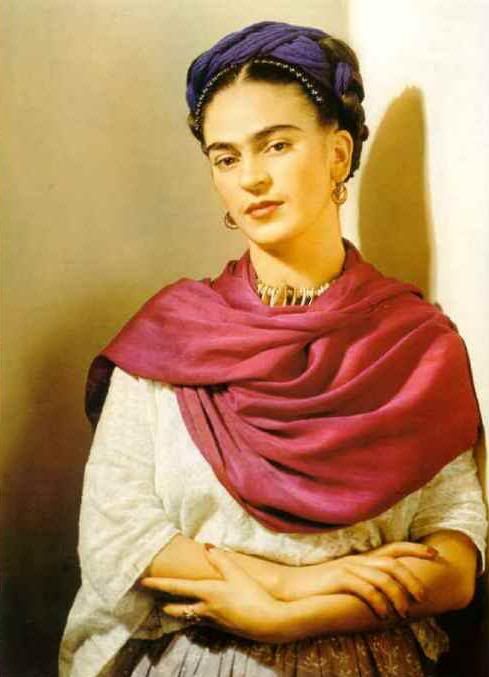 frida kahlo i should have started this thread yesterday, since it was her 103rd birthday. but i doubt she will care that i am a day late. 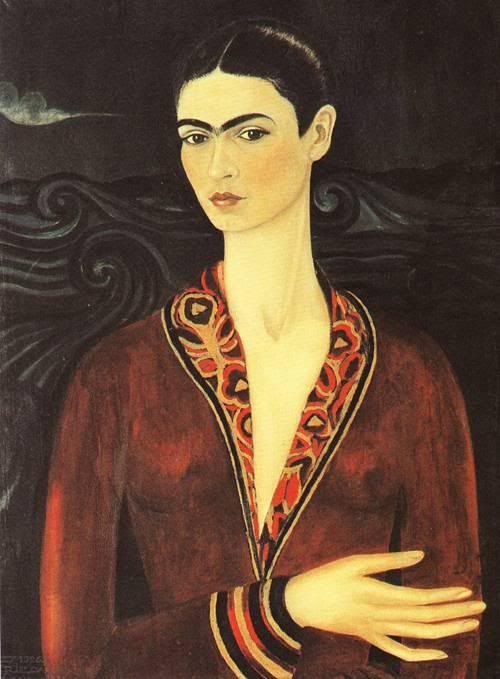 self portrait in a velvet dress 1926 self portrait in a velvet dress 1926i have calli to thank for introducing me to her. i am ashamed to say i had never even heard of her before he sent me the movie, frida (2002). salma hayek did an incredible job of portraying the mexican artist. alfred molina played the part of her husband and mentor, diego rivera. it won two oscars and if you've never seen it, even if you aren't a fan of frida's, watch it anyway. her story is amazing. 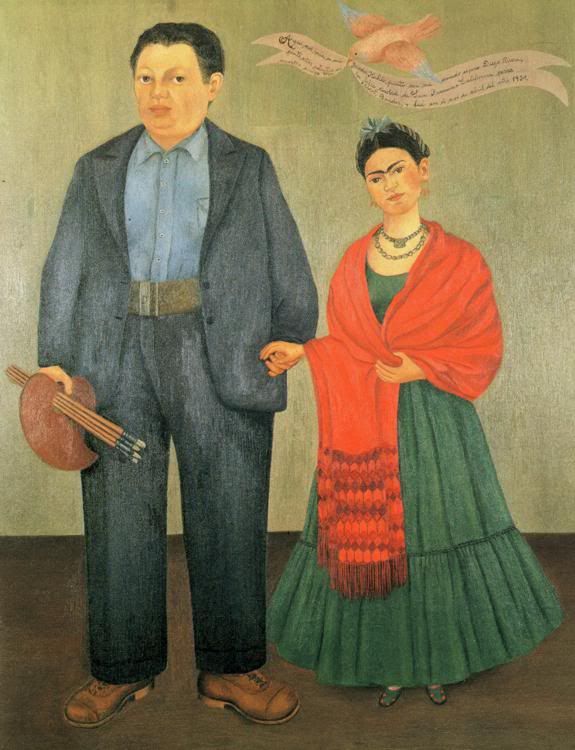 frida and diego, 1931 frida and diego, 1931though her birth certificate says she was born july 6th, 1910, she claimed it was actually july 7th. she said she wanted the year of her birth to coincide with the outbreak of the mexican revolution, so her life would begin with the birth of modern mexcio. right from the start she was controversial, rebellious and passionate. in school she became the ringleader of a group (mostly boys) that pulled a number of pranks on the professors. it was while she was still in school that she met her future husband, muralist diego rivera, who was commissioned to paint a mural in the school auditorium. 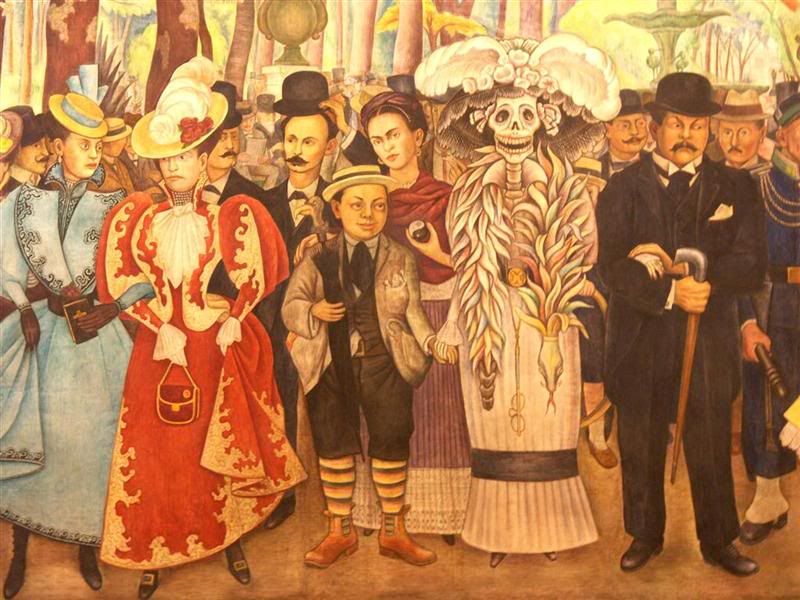 dream on, by diego rivera - shows diego as a child, at his and frida's wedding dream on, by diego rivera - shows diego as a child, at his and frida's weddingfrida was plagued with health issues, beginning at age six, when she was stricken with polio. but on september 17, 1925, when a bus she was riding collided with a trolley car, her life would change forever. it was a miracle she lived at all - a metal handrail pierced her abdomen and exited through her vagina. her spinal column was broken in three places. her collarbone, a few ribs and her pelvic were all broken. her right leg, which had become thinner than her left leg due to the polio, was fractured in eleven places. her foot was dislocated and crushed.  broken column, 1944 broken column, 1944no one thought she would live, but she was home within a month. the following months she spent in bed is where she began to paint. her most often subject was herself. she was quoted to say, "i paint myself because i am so often alone, because i am the subject i know best."  self portrait on the borderline between mexico & the united states 1932 self portrait on the borderline between mexico & the united states 1932her recovery was indeed miraculous, but the after effects would cause her great pain throughout the remainder of her life. she had numerous surgeries and ended up losing her right leg below the knee toward the end of her life. her paintings reflect a lifetime of physical and emotional pain and some of them are just jump out at you, because of that. she used alcohol, pills and affairs to deal with the pain, but it was her painting that gave her a reason to live. that and diego. their marriage was not conventional to say the least. they both had many affairs (frida was always ahead since she was also bisexual) they both tolerated until diego slept with frida's sister. the marriage ended, but they did get back together eventually. diego was always very supportive of frida's work and always encouraging. 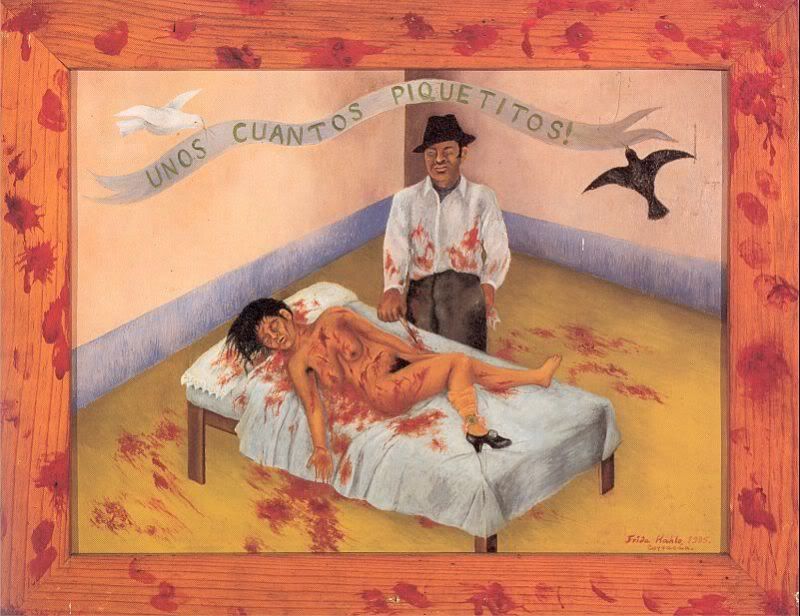 a few little pricks, 1935 a few little pricks, 1935she died in 1954. the last words in her diary read, "i hope the leaving is joyful and i hope never to return." in addition to the movie frida, the life and times of frida kahlo is also extremely interesting. made by PBS in 2006 - definitely worth checking out. 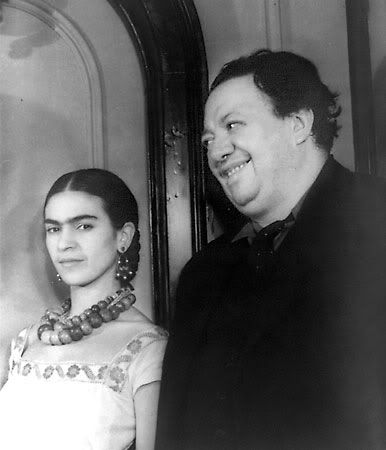 frida and diego frida and diego |
|
|
|
Post by spackle on Jul 7, 2010 12:38:39 GMT -5
Thanks for that, groupie, I've admired her work for a while, but didn't know it was her birthday. Happy birthday Frida!
|
|
|
|
Post by callipygias on Jul 8, 2010 0:38:27 GMT -5
it won two oscars and if you've never seen it, even if you aren't a fan of frida's, watch it anyway. her story is amazing. The movie is an example that the Oscars sometimes get it right*: it won for original score. It has a couple of the most powerful musical scenes in it I've ever seen. The one leading to this self-portrait is incredibly moving. 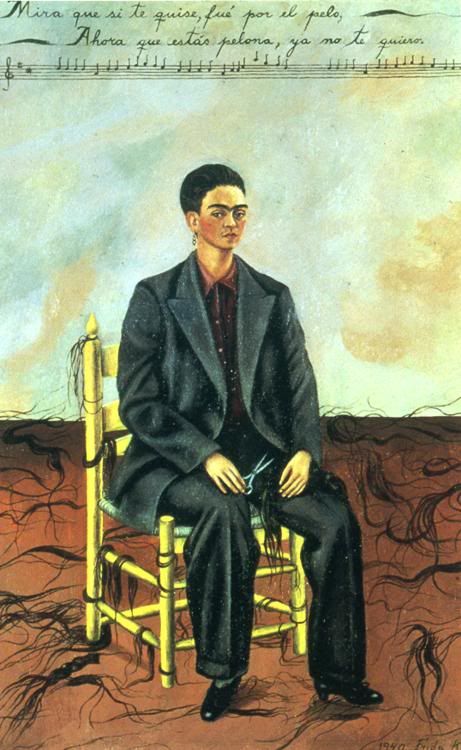 *Oscar got it wrong later that night when they gave Best Actress to Nicole Kidman instead of Salma Hayek, though.  |
|
|
|
Post by solgroupie on Jul 8, 2010 14:33:25 GMT -5
 dorothy hale dorothy hale
1905-1938dorothy hale was known as an off and on actress, ziegfield girl, socialite and friend of both frida kahlo and playwright, claire boothe luce. hale had fallen on hard times, as her husband was killed when his car plunged off a 500 foot cliff in california. her career as an actress was quickly evaporating and she was in terrible financial trouble, having to depend on friends for their charity. one night she invited all her friends to a party and announced she was going to take a long trip. they partied all night and after saying goodbye to them all, writing a few goodbye letters and finishing off the vodka, hale changed into a black velvet dress and added a corsage of yellow roses. then she jumped to her death from her high rise apartment. luce and frida discussed the possibility of frida painting a portrait of hale. luce thought it would be a good idea and asked frida what her price was. she agreed to it and said as soon as frida finished it, she would send it to hale's mother.  the suicide of dorothy hale, 1938 the suicide of dorothy hale, 1938this turned out to be one of frida's most controversial portraits. the painting shows the progression of hale's suicide from the jumping to her bloody death on the pavement below. in blood red lettering, frida added: “In New York City on the 21st of October 1938, at 6:00 in the morning, Dorothy Hale committed suicide by throwing herself from a very high window in the Hampshire House. In her memory, this portrait was executed by Frida Kahlo.”  frida don't play frida don't play that picture was taken while she was working on portrait of mrs. jean wight in 1931. frida highly disliked jean; maybe that is why the portrait has a bit of a cold feeling to it that picture was taken while she was working on portrait of mrs. jean wight in 1931. frida highly disliked jean; maybe that is why the portrait has a bit of a cold feeling to itwhen luce received the painting, she was quoted as saying,"When I pulled the painting out of the crate…I felt really physically sick. What was I going to do with this gruesome painting of the smashed corpse of my friend, and her blood dripping down all over the frame? I could not return it – across the top of the painting there was an angel waving an unfurled banner which proclaimed in Spanish that this was ‘The Suicide of Dorothy Hale, painted at the request of Clare Boothe Luce, for the mother of Dorothy’. I would not have requested such a gory picture of my worst enemy, much less of my unfortunate friend.” 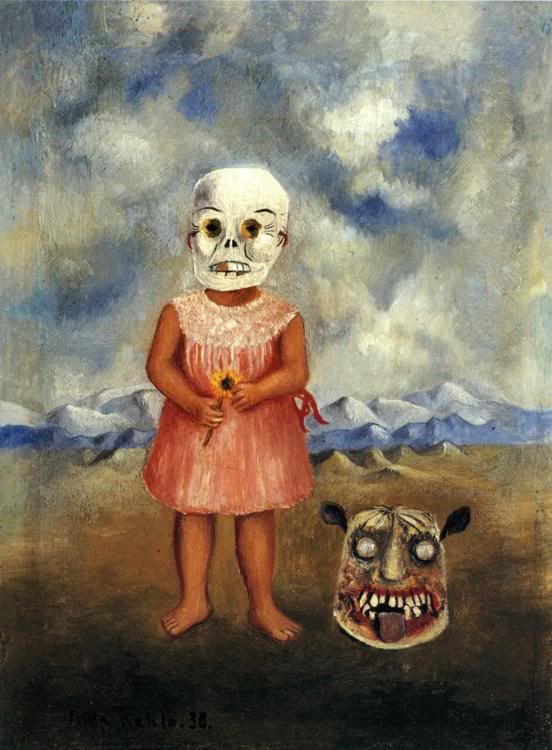 girl with death mask, 1938 girl with death mask, 1938evidently, frida had suggested she paint a "recuerdo," of hale. i looked that up, and i am pretty sure one of the definitions - other than a remembrance - is a "flashback." luce clearly misunderstood frida's intentions. luce gave the painting to a friend who was also a painter and sculptor, and had him paint over the angel. it stayed hidden for decades before it was re-discovered. some have thought that frida was simply mirroring her own desperate thoughts as she and diego were separated at the time the painting was done. |
|
|
|
Post by Bix Dugan on Jul 8, 2010 17:19:08 GMT -5
I saw the movie with (because of?) Salma Hayek. She lead an interesting life, that's for sure.
|
|
|
|
Post by solgroupie on Jul 8, 2010 19:39:07 GMT -5
A FEW PORTRAITS OF AND BY FRIDA KAHLO 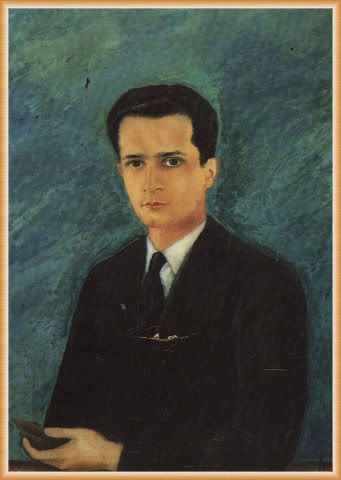 portrait of augustin olmedo, 1927 portrait of augustin olmedo, 1927other than herself, frida began her career as an artist by painting portraits of family and friends. this is a painting of close friend, augustin olmedo. if you are familiar with kahlo’s work, you can immediately tell this is one of her earlier portraits. for one thing, it has more of a classic renaissance style to it, with the plain background, which is unlike her later works. also, the left eye is slightly larger than the right one. either the guy had an unfortunate thing going on with his eyes, or frida had yet to fully develop her skills. still, it's a helluva lot better than anything i could ever do. the original painting took a hit near the center of the subject’s coat and was damaged by frida herself when she found out augustin had said of her: she isn’t worth not even a cent. 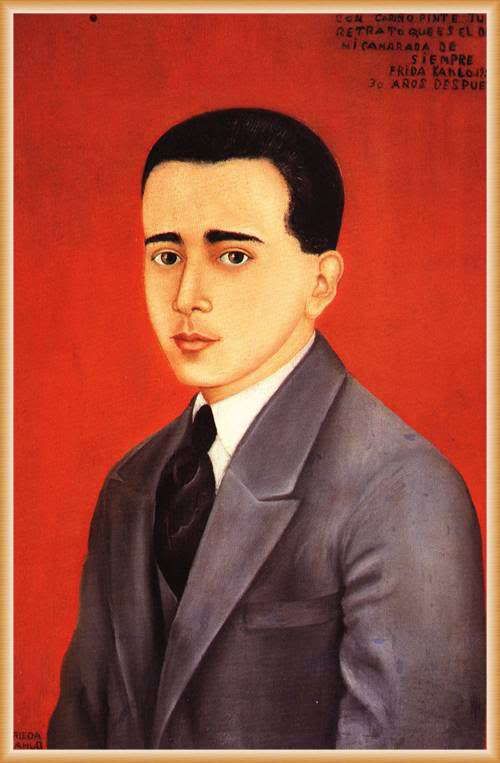 portrait of alejandro gomez arias, 1928 portrait of alejandro gomez arias, 1928it says in the upper corner: alex, with affection i painted your portrait, that he is one of my comrades forever, frida kahlo, 30 years later. alex was frida’s boyfriend she met at mexico’s national prep school in 1922. they were very close for three years and alex was with frida on the bus the day it collided with the trolley that nearly killed her. alex was not seriously injured, and he could be responsible for saving frida’s life by convincing the doctors to try and save her, since they had decided she was too far gone to even try. while recuperating in bed, frida constantly wrote to alex, where she said, what is going to happen in 30 years, and how and i going to be when i’m 30?they separated in 1928. the painting was lost for decades and supposedly found sixty-six years later, but it was declared to be a fake. it’s authenticity is questioned to this day.  portrait of cristina, my sister 1928 portrait of cristina, my sister 1928still using something of a classic renaissance style, frida’s younger sister, cristina, was the second member of the kahlo family to be painted. the previous year she did her older sister, adriana.  portrait of adriana, 1927 portrait of adriana, 1927adriana was the first member of the family that frida immortalized. only photos of the painting exist today - the the original’s whereabouts are unknown.  self portrait - time flies 1929 self portrait - time flies 1929frida painted this the year she and diego married. it is easy to see his influences in this, if you look at her first self portrait she did.  self portrait, 1926 self portrait, 1926 the colors were a bit dark and gloomy and frida painted herself as something of an aristocrat. in the one she painted in 1929, she seems to use the traditional mexican folk style that would dominate her work for the rest of her career - using bright colors and giving life to the background. in 2000, self portrait -time flies was auctioned off at sotheby’s in new york for five million dollars. 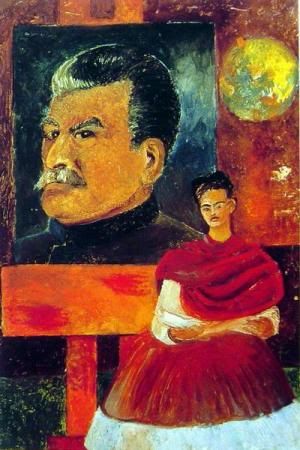 self portrait with stalin 1954 self portrait with stalin 1954at the end of her life, frida began incorporating her passionate political convictions more frequently (as well as more obviously)into her work. i read that she had an almost schoolgirl adoration for joseph stalin. it was thought the details are not as sharp as her paintings usually were, because of the pain medication she was on at that time. |
|
|
|
Post by solgroupie on Jul 8, 2010 19:40:39 GMT -5
it won two oscars and if you've never seen it, even if you aren't a fan of frida's, watch it anyway. her story is amazing. The movie is an example that the Oscars sometimes get it right*: it won for original score. It has a couple of the most powerful musical scenes in it I've ever seen. The one leading to this self-portrait is incredibly moving. absolutely. it was one of the most powerful scenes in a movie that was filled with them. |
|
|
|
Post by solgroupie on Jul 11, 2010 18:43:49 GMT -5
the culture of mexico and frida kahlo though frida is mainly known for her self portraits, she also did many portraits of others - family, friends and others unknown. it was diego that encouraged frida to use more subjects and scenes that were local to their rich mexican culture. he influenced her once they were together and eventually married to use more bright colors and backgrounds in her paintings. here are a few examples of native mexican and indian people. 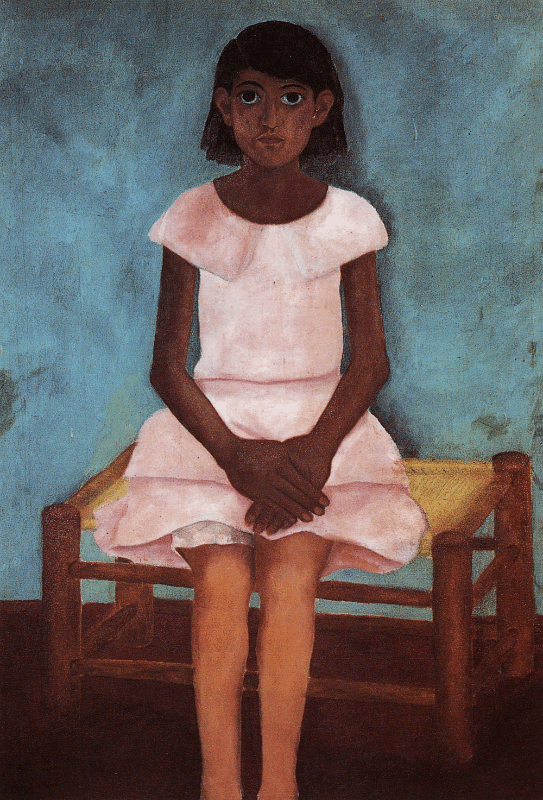 portrait of a girl, 1929 portrait of a girl, 1929though it lacks the bright colors and style frida would eventually develop, it shows her great talent for simplicity that still carries depth. the girl in the portrait is unknown.  the bus, 1929 the bus, 1929this is one of my favorite kahlo paintings. like diego, frida mixes a variety of mexican class in this painting. you can't help but think of the tragic trolley/bus accident that nearly killed frida when you look at it, and she uses at least two (that i know of) reminders - other than the setting of the painting taking place on a bus. the man in the blue overalls could be an homage to the man who was there the day of the accident - it was reported a man in blue overalls pulled the handrail that pierced frida's body. and the other man is holding a bag that could be a nod to the bag of gold dust that was being transported that day - the force of the crash was so great, frida's clothes were ripped from her body and they said the gold dust spilled all over her body. it must have been quite a scene after the accident - the chaos of the smashed bus and trolley and injured and frightened people, and frida's bloodied broken nude body covered in gold dust. it is somehow so frida.  the deceased dimas, 1937 the deceased dimas, 1937it is a mexican tradition, dating back to the 16th century to memorialize a dead child through a portrait. the child in this painting was the son of a local indian woman who sometimes modeled for diego. he is dressed in honor of saint joseph, the patron saint of new mexico.  four inhabitants of mexico city, 1938 four inhabitants of mexico city, 1938this strange painting features a small mexican girl (possibly frida, but she isn't sporting the traditional unibrow) in a traditional tehuana costume, which frida herself favored. the other characters were said to be possible artifacts owned by diego and frida. the large figure on the left is wearing overalls, which could remind us of diego. they are inside a large arena that was near frida's home, which seems to be completely desolate. frida was quoted to say, the plaza is empty because too much revolution has left mexico empty. 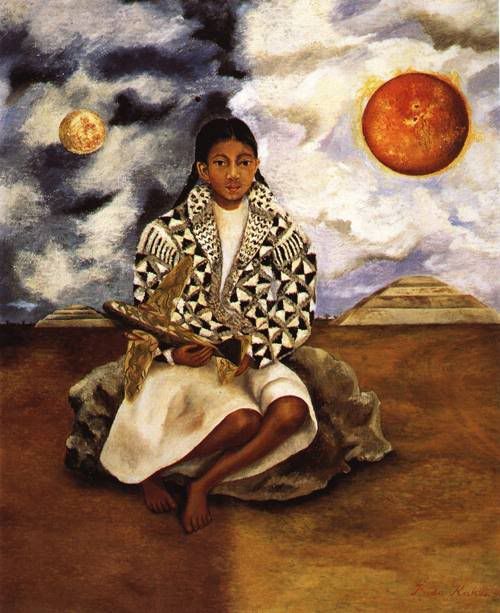 portrait of lucha maria, a girl from tehuacan, 1942 portrait of lucha maria, a girl from tehuacan, 1942here is an indigenous girl in a desert landscape, caught between night and day. she is wearing the traditional tehuana costume. she is also holding a model of a military airplane, which might be an acknowledgment of world war II.  girl with death mask (she plays alone), 1938 girl with death mask (she plays alone), 1938this little girl (again, could be frida, but who knows?) is wearing a mask that was traditionally worn during mexico's annual day of the dead celebration. she is holding a yellow flower that is similar to one commonly used to place on graves on this tradition. 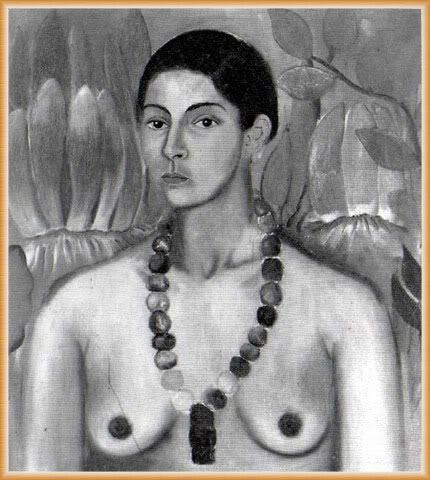 indian woman, nude, 1929 indian woman, nude, 1929here is another example of frida using native mexican and indian women for subjects in her portraits. this is just a picture of the original. |
|
|
|
Post by solgroupie on Jul 16, 2010 15:59:08 GMT -5
frida in pain, part I no doubt about it, frida kept a sort of living journal of her life through her paintings. sometimes the simplest things in her paintings can be just a small acknowledgment of the great emotional or physical pain she was experiencing at the time. other times, her paintings reflected her anguish so well they were just like looking at an open wound. one thing i have never understood or appreciated were critics who claim to know what every last object symbolizes in a painting. sometimes i can grudgingly admit that it is probably truth, but other times i don't. sometimes an apple is just an apple. so i will not to try to do that here, but i've read a great deal about her paintings in the last few weeks, which certainly doesn't qualify me as anything but a still clueless admirer; i am only going by what i think they could possibly mean.  frida and the cesarean operation, 1932 frida and the cesarean operation, 1932this unfinished painting was started prior to a devastating and life-threatening miscarriage frida suffered in the spring of 1932. this was the second time frida became pregnant after marrying diego, who never wanted children like frida did. after a failed attempt to abort the pregnancy, frida was told by doctors she could probably carry the child to term as long as she had a cesarean. the painting seems to convey both the hope and the fear frida was feeling at the time. she had the miscarriage before she could finish it. shortly afterwards she began one of her most famous and memorable works - 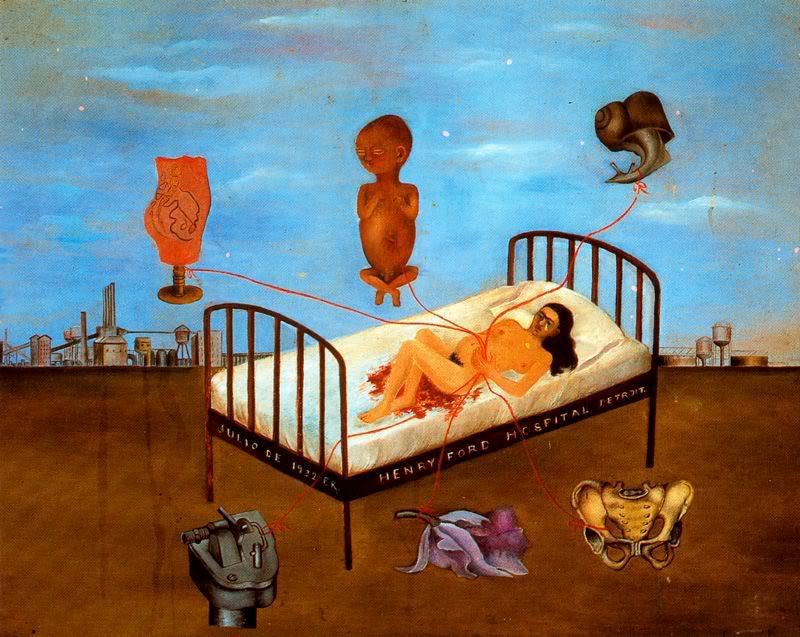 henry ford hospital (the flying bed), 1932 henry ford hospital (the flying bed), 1932though some might think this is one of frida's more disturbing portraits, it only makes me feel terrible sadness for her loss and the despair she must have been feeling. the figures surrounding her bed are connected to her, as if by umbilical cords as she lays on a blood soaked bed. one, of course, is the baby she hoped to have. the snail might suggest the slow, agonizing process of the miscarriage itself, or the time she spent worrying about the outcome of the pregnancy. of the plastic looking female torso, frida said it was an idea of explaining the insides of a woman. she invented a scary looking machine as to explain the mechanical part of the whole business. the orchid was a gift from diego after the miscarriage and the broken pelvis is pretty evident as an image of her own broken and fragile body that cannot have children. what moves me the most in this painting is the large tear on frida's face.  the wounded table, 1940 the wounded table, 1940this was one of frida's largest paintings, measuring around four by eight feet. some thought she did it purposely because it would be shown at an exhibition where diego would be showing significantly smaller works, and this was a time when frida was pretty fed up with diego's cheating, as it was painted during their divorce. resembling a bizarre reproduction of the last supper, the wounded table features frida at the center, much like jesus christ, surrounded by some eclectic characters. an over sized "judas" is to her right, which looks like diego - much larger than frida, wearing his usual overalls. i'm sure it was easy for frida to associate diego with judas after his affair with her sister. the judas and the skeleton were also featured in the four inhabitants of mexico, that she painted two years earlier. two of christina's children are also featured, as well as a pre-columbian sculptor and her pet deer, granizo. there are many references to frida's injured foot and legs - the skeleton and judas both have bandaged and bloody feet, the table appears to have damaged human legs, and even the idol has peg legs. frida said she gave the painting to a museum in moscow, but its whereabouts are unknown now. 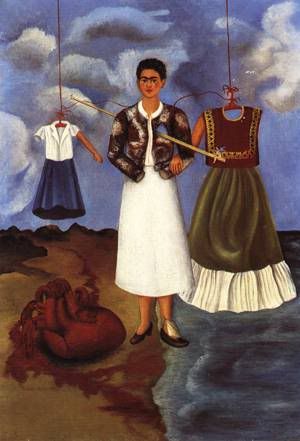 memory, 1937 memory, 1937the affair between her husband and her beloved sister must have been nearly unbearable for frida. christina's abusive husband had left her and their two children, so they were living with frida when the affair began. though frida knew going into her marriage with diego that he would continue his affairs, she was still hurt with each one he had. she dealt with it through her paintings and numerous affairs of her own. but sleeping with christina crossed the line. frida's broken heart is at her feet and the size of it suggests the comparison to how great her hurt was, as does the fact that she has no hands - which seems to imply how helpless she feels about the situation. her hair is short - she cut it short shortly after the discovery of diego and christina's affair. she is not dressed in her usual tehuna costumes that diego favored - it is hanging next to her, empty. so is the schoolgirl outfit on the other side, which might be a reminder of a simpler time for frida when she first met diego when she was still in school. her body is pierced - once more, but this time by diego and christina's betrayal, and her foot looks damaged, which coincides with a recent operation she'd had. this painting was auctioned at christie's in new york city in 1992 for $935,000.00. the part that disturbs me the most are the single arms on the otherwise empty dresses, especially the school uniform, which appears (to me) to be reaching for frida. 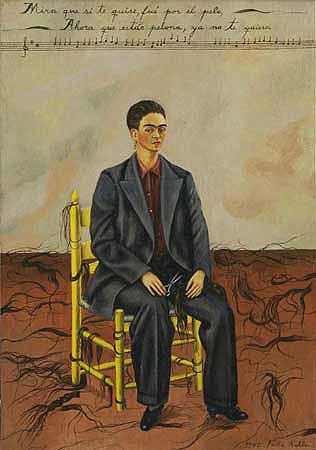 self-portrait with cropped hair, 1940 self-portrait with cropped hair, 1940as calli pointed out, this is one of frida's most powerful paintings that represented the pain she felt after discovering diego and christina's affair. it is indeed one of the best scenes in frida. this was the first self-portrait frida did after the divorce. maybe she cut her hair short because diego loved it long. maybe she only did it as an expression of her anger and pain. she wears a large suit, which could be one of diego's, but frida wore men's suits from time to time - 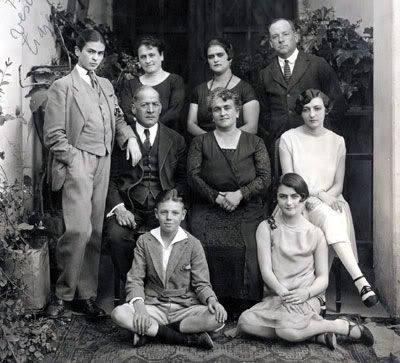 as she did in ^this 1926 family portrait. her hair is scattered everywhere and she holds a lock as a trophy of her act of self-mutilation. lyrics to a song are painted above, which lacks the color and life frida normally used in her work - see, if i loved you, it was for your hair, now you're bald, i don't love you anymore. |
|
|
|
Post by solgroupie on Jul 22, 2010 16:13:03 GMT -5
frida in pain, part II 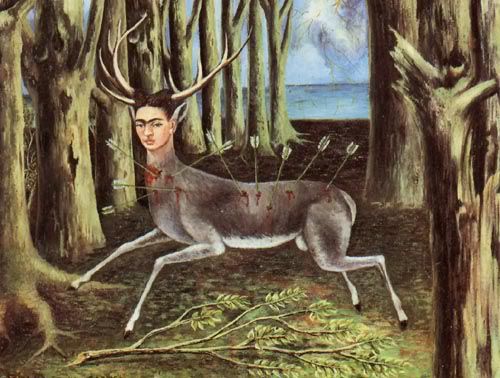 the wounded deer. 1946 the wounded deer. 1946frida painted this shortly after an operation that she hoped would cure her chronic back pain. she endured 30 operations in her lifetime since the trolley accident, and some seemed to worsen her condition, rather than improve it. i see no great symbolism here - other than the pain and frustration she was feeling at the time - especially since most of the arrows run along her back. a good model for this painting most likely came from frida's pet deer, granizo. 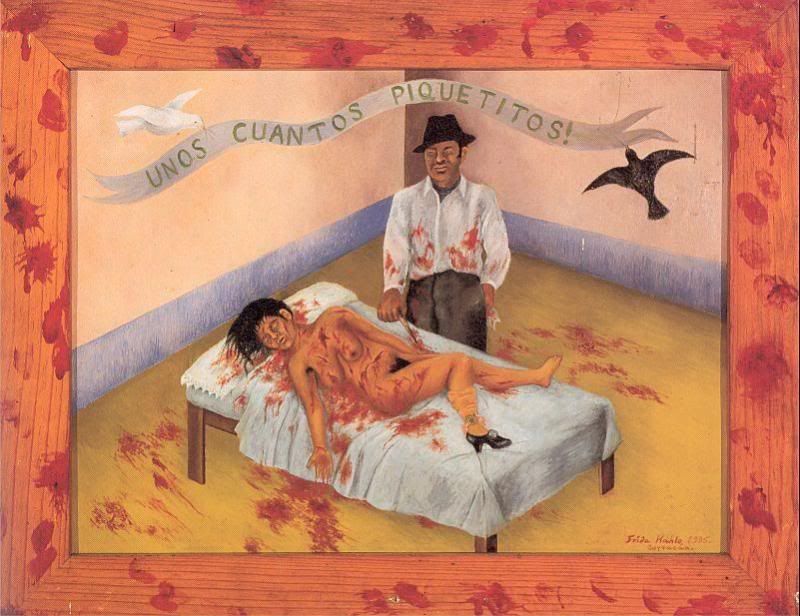 a few small nips, 1935 a few small nips, 1935definitely one of frida's more disturbing works, a few small nips came from a newspaper story that caught her attention. evidently, an unfaithful woman was viciously murdered by a jealous lover, who said in his defense to the judge, "it was just a few small nips!" (or something along those lines.) frida's anger and pain at diego and christina's betrayal is pretty visible here, since this was painted around the time of the affair's discovery. frida said she felt pity for the woman since she herself felt murdered by life. 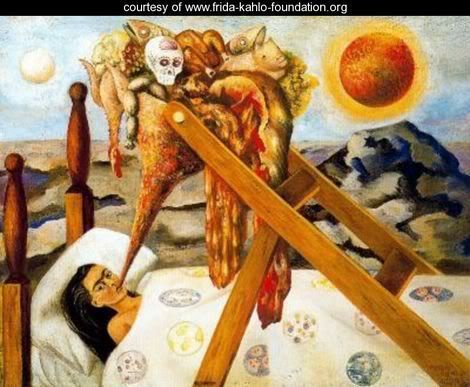 without hope, 1945 without hope, 1945so many years of surgeries and illnesses began to take its toll on frida, and she became too thin. doctors ordered her to remain in bed to rest and a fattening diet of pureed foods every two hours. the title of the painting pretty much sums up how frida was feeling at the time she created this - she seems pinned down on the bed, unable to do anything but listlessly feed on something that definitely doesn't look nourishing or appetizing. on the back of the painting she wrote, not the least hope remains for me...everything moves in step with what's in the belly.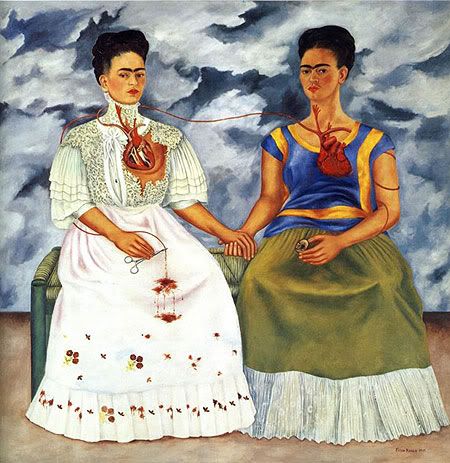 the two fridas, 1939 the two fridas, 1939this is a very telling piece of frida's art that she painted shortly after her divorce from diego. the frida on the right represents the person diego loved, dressed in her traditional tehuana costume. in her hand she holds an amulet of diego as a child. the frida on the left looks colder, more european somehow - the frida that diego betrayed and left. both hearts are exposed, and a vein runs from the amulet through both fridas until it is cut off by what looks like a surgical tool in the unloved frida's hand. only the heart in the frida on the right looks healthy and unbroken. in 1947 the two fridas was purchased by the national institute of fine arts in mexico city, paying frida around $1000 - the most she was ever paid for one of her paintings in her lifetime. 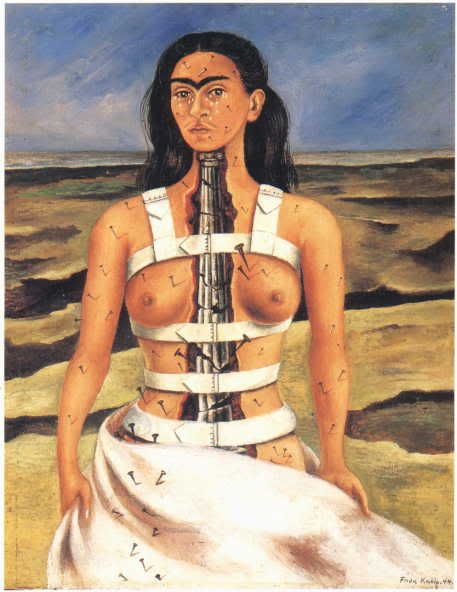 the broken column, 1944 the broken column, 1944this is one of frida's most painful works - i don't know how anyone could look at this and not be moved by it. most of the time, frida did her self portraits surrounded by plants, monkeys, parrots - life of some kind. but it almost seems she is trying to tell us how hard it was for her to deal with her physical pain alone. when she painted this, frida was wearing a steel corset, one she had to wear for five months. she described it as punishment. her cracked and broken spine always makes me appreciate my good health and makes me sit or stand a little straighter. the nails all over her body remind us again of her constant pain. |
|










































